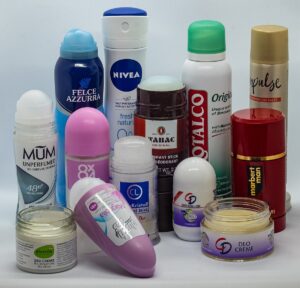
Ever notice that deodorants, lotion, body spray, shampoo, and other personal care products can be smelled in the air long after they have been used? Well... this is because they leave behind a mixture (cocktail) of all sorts of chemicals in the air. Researchers found that a mixture of over 200 volatile organic compounds (VOCs) are released into the air when these personal care products are used.
These chemicals lower air quality - so they are causing indoor air pollution. New harmful chemicals and particles can even be formed. And yes, these chemicals are then breathed in by us - so they get into our lungs and our bloodstream. They are not healthy for us, but we don't know the full range of long-term effects from constantly breathing in polluted air.
Some examples of the many chemicals released into the air (VOCs) by personal care products are monoterpenes (from added fragrances), acetaldehyde, alcohols, glycols, siloxanes, and alkanes. Monoterpenes are known to be damaging to lung when inhaled.
Bottom line: Open windows, ventilate indoor spaces as much as possible, use air cleaners or purifiers, and use unscented personal care products as much as possible. Also, try to use fewer personal care products.
From phys.org (a science and technology site): How personal care products affect indoor air quality
The personal care products we use on a daily basis significantly affect indoor air quality, according to new research by a team at EPFL. When used indoors, these products release a cocktail of more than 200 volatile organic compounds (VOCs) into the air, and when those VOCs come into contact with ozone, the chemical reactions that follow can produce new compounds and particles that may penetrate deep into our lungs. Scientists don't yet know how inhaling these particles on a daily basis affects our respiratory health.
It all began when Dusan Licina, a tenure-track assistant professor at EPFL, and his group drew up an apparently unremarkable shopping list: roll-on deodorant, spray deodorant, hand lotion, perfume and dry shampoo hair spray—all produced by leading brands and available in major stores across Europe and elsewhere.
Licina leads EPFL's Human-Oriented Built Environment Lab (HOBEL) at the Smart Living Lab in Fribourg, home to environmental chambers—unique experimental facilities resembling real indoor spaces that enable precise control and monitoring of indoor air quality.
The research project, led by Licina's former postdoc Tianren Wu, worked in association with researchers from Germany and Sweden to mimic the use of these personal care products in an indoor environment. In one test, the researchers applied the products under typical conditions, while the air quality was carefully monitored. In another test, they did the same thing but also injected ozone, a reactive outdoor gas that occurs in European latitudes during the summer months.
Ozone can infiltrate homes through open windows, but can also come from indoors, for example, when using laser printers and 3D printers....
It took the scientists two years to process all the collected data. In the first case without ozone, over 200 VOCs were emitted from the personal care products, which gradually dissipated with ventilation. The most abundant molecules they found were ethanol and monoterpenes, typically used in these products.
However, when ozone was introduced into the chamber, not only new VOCs but also new particles were generated, particularly from perfume and sprays, exceeding concentrations found in heavily polluted urban areas such as downtown Zurich.
"Some molecules 'nucleate'—in other words, they form new particles that can coagulate into larger ultrafine particles that can effectively deposit into our lungs," explains Licina. "In my opinion, we still don't fully understand the health effects of these pollutants, but they may be more harmful than we think, especially because they are applied close to our breathing zone. This is an area where new toxicological studies are needed."
Preventive measures
To limit the effect of personal care products on indoor air quality, we could consider several alternatives for how buildings are engineered: introducing more ventilation—especially during the products' use—incorporating air-cleaning devices (e.g., activated carbon-based filters combined with media filters), and limiting the concentration of indoor ozone.
Another preventive measure is also recommended, according to Licina: "I know this is difficult to hear, but we're going to have to reduce our reliance on these products, or if possible, replace them with more natural alternatives that contain fragrant compounds with low chemical reactivity. Another helpful measure would be to raise awareness of these issues among medical professionals and staff working with vulnerable groups, such as children and the elderly."
